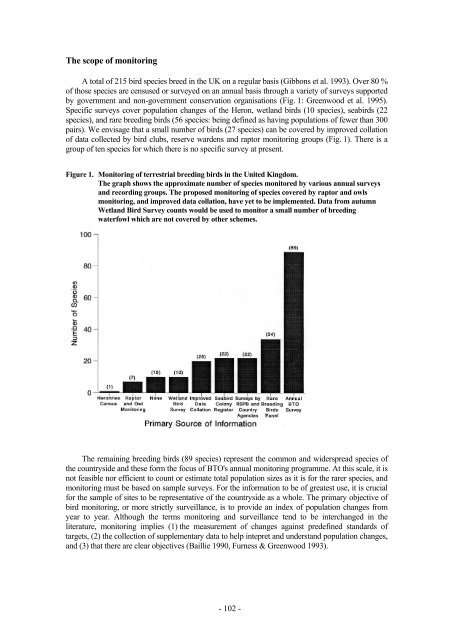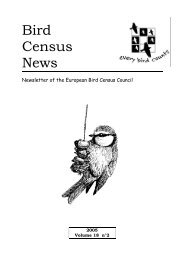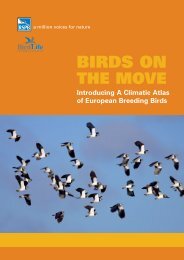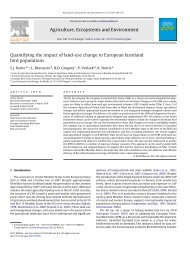monitoring breeding birds in the united kingdom - European Bird ...
monitoring breeding birds in the united kingdom - European Bird ...
monitoring breeding birds in the united kingdom - European Bird ...
You also want an ePaper? Increase the reach of your titles
YUMPU automatically turns print PDFs into web optimized ePapers that Google loves.
The scope of <strong>monitor<strong>in</strong>g</strong><br />
A total of 215 bird species breed <strong>in</strong> <strong>the</strong> UK on a regular basis (Gibbons et al. 1993). Over 80 %<br />
of those species are censused or surveyed on an annual basis through a variety of surveys supported<br />
by government and non-government conservation organisations (Fig. 1: Greenwood et al. 1995).<br />
Specific surveys cover population changes of <strong>the</strong> Heron, wetland <strong>birds</strong> (10 species), sea<strong>birds</strong> (22<br />
species), and rare <strong>breed<strong>in</strong>g</strong> <strong>birds</strong> (56 species: be<strong>in</strong>g def<strong>in</strong>ed as hav<strong>in</strong>g populations of fewer than 300<br />
pairs). We envisage that a small number of <strong>birds</strong> (27 species) can be covered by improved collation<br />
of data collected by bird clubs, reserve wardens and raptor <strong>monitor<strong>in</strong>g</strong> groups (Fig. 1). There is a<br />
group of ten species for which <strong>the</strong>re is no specific survey at present.<br />
Figure 1. Monitor<strong>in</strong>g of terrestrial <strong>breed<strong>in</strong>g</strong> <strong>birds</strong> <strong>in</strong> <strong>the</strong> United K<strong>in</strong>gdom.<br />
The graph shows <strong>the</strong> approximate number of species monitored by various annual surveys<br />
and record<strong>in</strong>g groups. The proposed <strong>monitor<strong>in</strong>g</strong> of species covered by raptor and owls<br />
<strong>monitor<strong>in</strong>g</strong>, and improved data collation, have yet to be implemented. Data from autumn<br />
Wetland <strong>Bird</strong> Survey counts would be used to monitor a small number of <strong>breed<strong>in</strong>g</strong><br />
waterfowl which are not covered by o<strong>the</strong>r schemes.<br />
The rema<strong>in</strong><strong>in</strong>g <strong>breed<strong>in</strong>g</strong> <strong>birds</strong> (89 species) represent <strong>the</strong> common and widerspread species of<br />
<strong>the</strong> countryside and <strong>the</strong>se form <strong>the</strong> focus of BTO's annual <strong>monitor<strong>in</strong>g</strong> programme. At this scale, it is<br />
not feasible nor efficient to count or estimate total population sizes as it is for <strong>the</strong> rarer species, and<br />
<strong>monitor<strong>in</strong>g</strong> must be based on sample surveys. For <strong>the</strong> <strong>in</strong>formation to be of greatest use, it is crucial<br />
for <strong>the</strong> sample of sites to be representative of <strong>the</strong> countryside as a whole. The primary objective of<br />
bird <strong>monitor<strong>in</strong>g</strong>, or more strictly surveillance, is to provide an <strong>in</strong>dex of population changes from<br />
year to year. Although <strong>the</strong> terms <strong>monitor<strong>in</strong>g</strong> and surveillance tend to be <strong>in</strong>terchanged <strong>in</strong> <strong>the</strong><br />
literature, <strong>monitor<strong>in</strong>g</strong> implies (1) <strong>the</strong> measurement of changes aga<strong>in</strong>st predef<strong>in</strong>ed standards of<br />
targets, (2) <strong>the</strong> collection of supplementary data to help <strong>in</strong>tepret and understand population changes,<br />
and (3) that <strong>the</strong>re are clear objectives (Baillie 1990, Furness & Greenwood 1993).<br />
- 102 -






